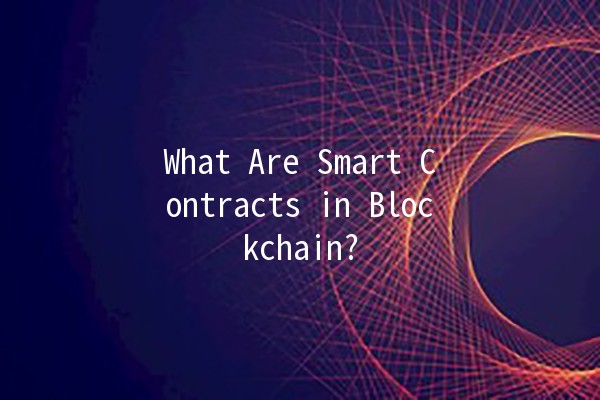




Blockchain technology has revolutionized how we think about data and transactions, making processes more secure, transparent, and efficient. One of the cornerstone innovations that have emerged from the blockchain landscape is the concept of smart contracts. But what exactly are smart contracts, and how do they function within the blockchain ecosystem? This article delves into the definition, characteristics, use cases, and productivity hacks regarding smart contracts, providing you with an indepth understanding of their significance in the digital age. We will also explore practical tips to enhance your productivity when working with smart contracts.
Smart contracts are selfexecuting contracts with the terms of the agreement directly written into code. They reside on a blockchain, enabling automated execution of agreements without human intervention. In simple terms, a smart contract can be thought of like a digital vending machine: you input (or fulfill) the contract terms, and the output (or agreement execution) is automatically provided without the need for a mediator.

The functioning of smart contracts involves several key steps:
Smart contracts have a variety of applications across numerous industries. Here are some practical examples:
Understanding how to increase productivity when working with smart contracts can significantly enhance your workflow. Here are five practical tips:
Prebuilt templates can save time and reduce the likelihood of errors. Many online platforms provide accessible smart contract templates tailored to various industries.
Example: OpenZeppelin provides communityvetted smart contract templates that you can modify according to your requirements.
Using an IDE that specializes in blockchain coding can streamline the development process. These environments often have builtin tools for testing and deploying contracts.
Example: Remix is a popular browserbased IDE that allows developers to write, test, and deploy smart contracts directly on the Ethereum blockchain.
Automated testing tools can help identify bugs or vulnerabilities in your smart contracts before deployment. This minimizes the risk of costly errors.
Example: Truffle framework provides automated testing features for Ethereum smart contracts, allowing developers to create robust contracts with fewer flaws.
Welldocumented code is easier to maintain and understand. Include comments within your smart contract to specify what each section does, making it easier to reference later.
Example: Use inline comments in Solidity code to describe the functions and variables clearly.
Conduct regular audits to ensure the security and efficiency of your smart contracts. Engaging thirdparty auditors can provide an unbiased analysis of your contract.
Example: Companies like ConsenSys offer professional auditing services that can spot vulnerabilities and recommend improvements.
Smart contracts are primarily written in languages that the underlying blockchain supports. For instance, Ethereum smart contracts are often written in Solidity, while Hyperledger supports Chaincode in languages like Go and JavaScript. Picking the right language is crucial depending on the blockchain you choose, as each has unique features and capabilities.
Smart contracts can be legally binding, but their enforceability can depend on jurisdiction and the legal framework governing them. Many jurisdictions have begun to recognize smart contracts as valid agreements, but it’s essential to ensure compliance with local laws. Businesses should consult legal experts when creating smart contracts to ensure they meet all necessary legal requirements.
Once deployed, making changes to a smart contract can be challenging, if not impossible. Errors may lead to unexpected behavior or even total loss of funds. It is vital to perform extensive testing and auditing before deployment to prevent this. If an error arises, one solution is to create a new contract that address the issues and transfer resources over.
Generally, smart contracts are immutable, meaning they cannot be altered or revoked after deployment. However, developers can design 'upgradeable contracts,' allowing logic to be updated through a proxy pattern. This approach allows you to maintain continuity while fixing any flaws that may arise in the contract’s logic over time.
Gas fees refer to the pricing mechanism on the Ethereum network (and others) for executing transactions or smart contracts. Users must pay these fees to miners, who process and validate the transactions. Fees vary depending on network congestion, the complexity of the contract being executed, and the amount of computational work required. Understanding gas fees is crucial when deploying contracts to avoid unexpected costs.
While smart contracts are designed to be secure, they are not entirely immune to vulnerabilities and hacks. Bugs in the code, flaws in design, or unintended logic can lead to exploitation. Therefore, regular audits, proper coding practices, and adherence to security standards are essential to mitigate risks and enhance overall security.
In summary, smart contracts are an integral part of the blockchain ecosystem, ushering in a new era of contractual agreements that are automated, secure, and transparent. Understanding their functionality, use cases, and best practices can provide a competitive edge in delivering innovative solutions across industries. As you explore the world of smart contracts, implementing the productivity tips outlined here can further enhance your efficiency and effectiveness in utilizing this groundbreaking technology.